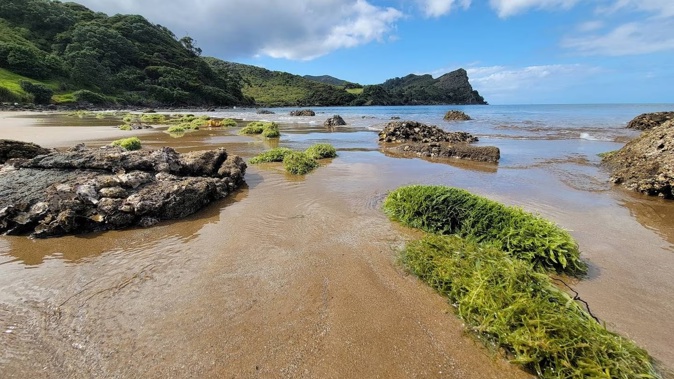
Northland Regional Council has launched a broadside at the government for being too slow to act over the new “foot-and-mouth” of New Zealand marine pests, that risks costing the country billions of dollars.
Council deputy chairman Jack Craw said the new invasive super spreader seaweeds caulerpa brachypus and caulerpa parvifolia were the worst marine pest threats he had seen in 40 years of biosecurity management.
The two highly invasive exotic seafloor species were first found in New Zealand on Great Barrier Island by members of the public in 2021. They have only been confirmed there and about 65km by sea south on Great Mercury Island, off Coromandel’s east coast.
Craw said they were the foot and mouth of New Zealand’s marine pests and the government hadn’t done enough to halt their spread since they arrived in the country.
His comments came at a Northland Regional Council (NRC) working party meeting in Whangārei this week, addressed by Wellington-based Ministry for Primary Industries (MPI) director of readiness and response services John Walsh – who leads the government’s caulerpa response.
/cloudfront-ap-southeast-2.images.arcpublishing.com/nzme/PXVAVBUKZJH6LPUPFI2G55AGP4.JPG)
NRC biodiversity and biosecurity working party chairperson Geoff Crawford said the implications of caulerpa for New Zealand well outweighed foot-and-mouth disease. Foot-and-mouth disease (FMD) is a highly-contagious viral disease which affects cloven hoofed (with two toes) animals including sheep.
Craw, said the government work to date was not enough.
Walsh said in response MPI had been working on limiting the spread of the caulerpa through shutting areas of infestation to visiting boaties. It was also doing selected surveillance via other organisations. Public education had been carried out and options for getting rid of the invasive pest had been looked into.
Walsh said the pest had most probably come with a vessel from the Indo-Pacific heading south to New Zealand.
He said the North Island’s east coast from Cape Reinga to East Cape was the major risk area for caulerpa. This coastline stretches for 1000 kilometres, but limited caulerpa surveillance has been done.
A piece of the new pest caulerpa species not much bigger than a freckle can grow to become a thick mat covering the area of a rugby field within a matter of weeks, depending on the time of year.
Cyclone Gabrielle saw 100 tonnes of the pest seaweed wash onto the Blind Bay Great Barrier Island shoreline - just 18 months after the invader’s presence was first identified.
Craw said the current process of simply confirming the presence of the pest after it arrived and then deciding what to do - as had been the case in New Zealand to date - was no use. A proactive plan was urgently needed ahead of any new identified locations - to be ready to swing into action immediately.
Caulerpa has not yet been found in Northland, or on inner Hauraki Gulf islands. However Great Barrier Island is only about 100 kilometres away and a hugely popular spot for boaties and commercial fishermen. Waiheke Islanders are so worried about caulerpa’s potential presence they have recently bought a remote operated vehicle to do their own monitoring.
Tūtūkākā-based ocean ecologist Glenn Edney told the meeting the pest had been badly underestimated in New Zealand to date.
“This is by far the most serious marine invasive species we have had in this country. So please take it seriously. It has been grossly underestimated in terms of seriousness,” Edney said.
“From where I am sitting with personal experience of caulerpa you don’t want to even have to think of the economic consequences. We’re not talking hundreds of millions we’re talking of billions of dollars in economic impact if this stuff gets away on us.”
He said some parts of the world had done nothing in advance of the marine pest and were now suffering the consequences.
/cloudfront-ap-southeast-2.images.arcpublishing.com/nzme/DYGBOLI32JHA7H3BAYANOZLUX4.JPG)
However a Delaware, United States community had got rid of local newly-arrived caulerpa in 17 days by having a pre-organised plan in place.
Craw said the new pest had the potential to wipe millions from New Zealand’s economy, and devastate the country’s economic, social, environmental and cultural essence. Its presence on Great Barrier and Great Mercury Islands was not simply a local issue, but one of national importance.
“It’s incumbent on MPI to take responsibility for the great welt of the problem and look at solutions and look at treatments.’’
■ Local Democracy Reporting is Public Interest Journalism funded through NZ On Air.
Take your Radio, Podcasts and Music with you









